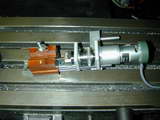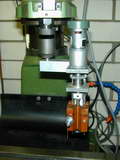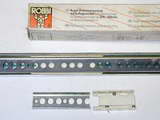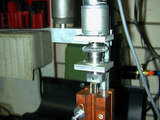Making and Using a Basic EDM
Page 3: Mechanics
Created: 2006-12-19
Click on photos to view them in more detail
Even though the mechanical forces on the EDM electrode will be minimal in operation, the usual requirements for a precision machine slide still apply: it must follow a predictable, linear path, free from slop and back-lash in the carriage drive lead-screw mechanism. Most of the home-construction designs I've seen use a circular ram that slides in some kind of bush system, with some way to prevent the ram rotating. Ben Fleming's design solves the problem very elegantly by using a commercial, ball-bearing based cabinet drawer slide as the ram. In effect, a poor-man's CNC ball-slide!
 The slide is actuated by a lead-screw driven by the DC servo motor. As this is fitted with a 100:1 reduction gearbox, the lead-screw pitch does not need to be especially fine. I decided to use UNC 1/4-20, screw-cutting the thread in the lathe and finishing off with a die adjusted to produce a close but free fit in a brass "nut". The nut, which must be made first, is 3/8" long to provide a decent thread length which will assist with minimising back-lash. I was prepared to fit an adjustable anti-backlash nut like those cunningly used on Sherline's tabletop machines, but this proved unnecessary.
The slide is actuated by a lead-screw driven by the DC servo motor. As this is fitted with a 100:1 reduction gearbox, the lead-screw pitch does not need to be especially fine. I decided to use UNC 1/4-20, screw-cutting the thread in the lathe and finishing off with a die adjusted to produce a close but free fit in a brass "nut". The nut, which must be made first, is 3/8" long to provide a decent thread length which will assist with minimising back-lash. I was prepared to fit an adjustable anti-backlash nut like those cunningly used on Sherline's tabletop machines, but this proved unnecessary.
Another simplification in Ben's design is the absence of any limit switch system, so if the ram hits a stop, the motor will stall, the current rise, and we are in danger of blowing the servo drive chip. As mentioned in the book review, there is an active Yahoo EDM group dedicated to this design. One of the contributors there posted details of a very simple slip-clutch that prevents the motor stalling if the end-stops are hit. It also provides compensation for any misalignment between the lead-screw and the motor shaft. A two-for-one advantage like this is hard to resist, so it was incorporated into my mechanics.
 This photo shows the finished ram. Moving left to right we start with the insulated block that holds the electrode. This is mounted on the lower end of the moving slide. The other end has a 3/8" thick aluminium block that mounts the lead-screw nut. Next is a 1/4" partition screwed to the fixed rail that carries a ball race. This is held in a blind recess in the partition by a clamp plate. the lead-screw has a shoulder that buts up to the ball race inner and is held firmly in place by the lower half of the slip-clutch. The longitudinal back-lash is whatever is in the ball race, which is to say, sod-all!
This photo shows the finished ram. Moving left to right we start with the insulated block that holds the electrode. This is mounted on the lower end of the moving slide. The other end has a 3/8" thick aluminium block that mounts the lead-screw nut. Next is a 1/4" partition screwed to the fixed rail that carries a ball race. This is held in a blind recess in the partition by a clamp plate. the lead-screw has a shoulder that buts up to the ball race inner and is held firmly in place by the lower half of the slip-clutch. The longitudinal back-lash is whatever is in the ball race, which is to say, sod-all!
The driven part of the clutch is just a drum fastened to the motor gearbox output shaft with a grub-screw that fits inside the lower "bell". 0.010" of clearance between drum and bell provide the self-aligning feature. The bell is drilled through on a diameter to carry two opposed 1/8" ball bearings that align with two of four orthogonal dimples in the driven part. The balls are prevented from escaping by an expansion spring that loops around the clutch bell. It fits in a recess around the outside of the bell and holds the balls in the detents tight enough to transfer driving force between the two. If the lead screw is prevented from rotating, the detents push the balls up against the spring so the motor can continue rotating while the clutch goes click, click, click... Reversing the motor gives an instant take up. Obviously, careful centering is required to align the nut carrier with the ball-race lead-screw carrier. The motor carrier need not be so precise, but is, anyway. To complete the unit, a bracket with a post allows the unit to be mounted to a chuck in the vertical mill.
 Even with the departures taken from the published design (screw-cut lead-screw and clutch), the mechanics where completed in a easy day in the shop. I suspect this is an area where many will apply some inventiveness to suit what is in the scrap-box! As long as the assembly is rigid, free from slop, and aligns as close to vertical as practical when mounted, all will be well.
Even with the departures taken from the published design (screw-cut lead-screw and clutch), the mechanics where completed in a easy day in the shop. I suspect this is an area where many will apply some inventiveness to suit what is in the scrap-box! As long as the assembly is rigid, free from slop, and aligns as close to vertical as practical when mounted, all will be well.

| Back: Electronics | EDM How-To Index | Next: Plumbing |
 Model Engine News Home
Model Engine News Home
This page designed to look best when using anything but IE!
Please submit all questions and comments to
[email protected]

